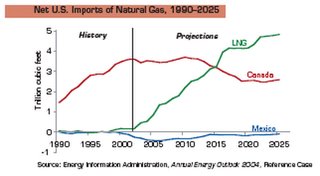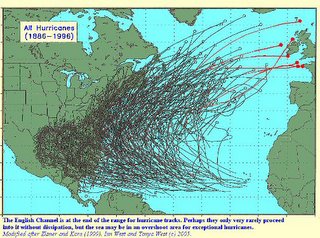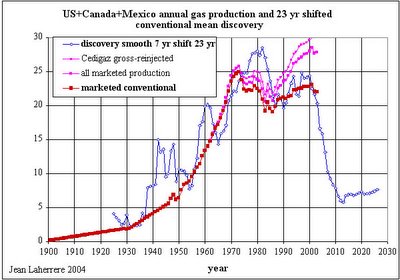Wednesday, January 25, 2006
Natural Gas - pictures and Graphs

As North American runs out of natural gas we will need to import it as liquified natural gas (LNG).
"As the technology of LNG liquefaction and shipping has improved, and as safety considerations have lessened, a major expansion of U.S. import capability appears to be under way. These movements bode well for widespread natural gas availability in North America in the years ahead."
Alan Greenspan 6/10/2003

This is where hurricanes go.

This is where the existing and planned LNG ports are.

This is what happens when hurricans hit offshore oil and gas facilities. "... Katrina... destroyed 46 platforms and damaged 20 others. Rita... destroyed 69 platforms and damaged 32 others..."
"... Katrina... destroyed 46 platforms and damaged 20 others. Rita... destroyed 69 platforms and damaged 32 others..."
"The storms’ combined fury... also damaged 183 pipelines, including 64 classified as major. As of Thursday, only 22 had been returned to service, the MSS (mineral management service) said."
"... at least one-sixth of the region’s normal daily oil production will still be off line at the start of next storm season..."
all quotes from ALAN SAYRE / The Associated Press, January 23, 2006

So perhaps you catch my drift. We need to begin using less natural gas, through efficiency, behavior change, solar thermal, buring biomass, buring biogas, ground sourced heat pumps, organic farming, etc.
Sunday, January 15, 2006
My home: walking my talk - Part One

I lived in a 50 year old brick home in the core of Madison. There are many errands and recreational activities that I can do by foot or bike. Including getting tea, a haircut, grocery shopping, going to the community garden plot, getting to the local pool, even when the mood strikes me biking to work. When I drive, I drive my Civic. I do get around a good bit by bike, and happen to love bikes. Currently I own four of them.
I am a major organic gardener of things edible. So I compost. I even collect my neighbors leaves in the fall. I use them mainly for late-spring/early summer mulching of garden beds (mulching keeps me from weeding, water from evaporating and soil from loosing nutrients). I grow lots of veggies as well as fruit (including, black berries, currants, cherries, stawberries, raspberries, grapes and plums). Probably about 70% of our annual veggies come from my gardens. That would include 100% of our jam, salsa, canned tomatoes, garlic, and pesto.
I use an electric lawn mower (having given up on push mowers) and usually have it on mulch. If not, I compost the clippings or again use them to mulch the garden beds. My yard has not seen petrochemical fertilizers, etc. since I moved in (about 9 years ago). A rain barrel under one downspot collects water for garden watering.
One of the more apparent items in my back yard is our solar electric system. It is pole mounted and follows the sun - it should generated about 30% more electricity than a fixed system. A picture is found above.
The solar electric system generates about 1800 kWh/year. This is about 400 kWhs less than my son and I use per year. If we unplugged the chest freezer or if there were fewer trees (i.e., shade) around it would meet all our electricity needs. Regardless our home uses 4% as much electricity as the average Wisconsin single family home (400 versus 10,000 kWh/year respectively).
My home's shell is very inefficient. It is made with masonry walls - without any insulation or open area to add insulation. As the exterior is beautiful brick my only option is to added interior insulation. Thereby further reducing my interior living space (about 1100 square feet). It is a gradual process - and takes years - my bedroom is done and the basement is about 80% complete.
Of course we uses efficient appliances and endevour to keep them to a minimum (i.e., no wine refrigerator or hot tub). Almost all the lights are compact florescents. I have a Energy Star refrigerator and laptop computer, and the most efficient freezer I could find a Sears. We do not have electrical heated water bed, central air conditioning, electric hot water heating or dryer. I do electrically heat my garden seedlings in the spring and food dryer (main for tomatoes) in the fall.
End of Part One
Thursday, January 12, 2006
Thoughts on future home heating

How will we heat our homes tomorrow? North American natural gas discoveries are on the decline and production could fall off a cliff in the next five to ten years. The graph shows North American natural gas discoveries and production with the discovery curve moved forward 23 years. The area under the two curves will be equal once all the natural gas has been used. This is real data.
Importing natural gas as liquified natural gas (LNG) is the mainstream solution. But that gas would come from the Middle East and Russia, and it would be expensive. Our trade deficite would explode. Also we would need the infrastructure to import all that LNG. The most challanging are the LNG port facilities. They regularly explode and are very much unwanted by neighboring communities. The mainstream solution: off shore LNG ports in the Gulf of Mexico. But what about all those hurricanes? They will have a high likelihood of knocking out the gas lines that run from the LNG port to the mainland. Some Gulf of Mexico gas lines are still out from hurriance Katrina.
Also I argue that the natural gas should be used first for fertilizers. I wonder if we can feed the world's billions without fertilizers, natural gas chemicals, etc?
So if not natural gas than what?
Let us consider: coal, solar thermal, propane, passive cooling, passive solar, pellet stoves, corn stoves, wood stoves. Coal is dirty, bulky, emits carbon dioxide, etc. Solar thermal (or passive heating) can only augment heating needs in northern tier states. Propane prices will follow natural gas prices. Passive cooling will help maintain a lower summer indoor temperature – but people wanting a "cool" home may not be satisfied. The cost of the pellets for pellet stoves will tend to track the cost of the primary heating fuel (natural gas). Corn stoves will be competing for the corn against ethanol plants and hungry stomachs. Wood stoves, perhaps for the few, the hardy with wood lots.
What is left? Electricity. And what is the most efficient electric technology. Well for those of us in the Northern tier it would be Ground Source Heat Pumps (GSHP). GSHP happen to be very efficient at heating and cooling. And they work on mainstream homes in conventional neighborhoods.
Some homes GSHPs use over 10,000 kWhs per year. These I consider failures. However some use much less. Here are two examples:
A relatively small, 1320 ft2, home in Sun Prairie, WI. It is a tract home built to Wisconsin code. Over a period of three years of data collection, the home’s GSHP consumed an average of 2510 kWhs/year. This could be met by an unshaded 2 kW fixed-mounted solar electric system (requiring 200 ft2 of unshaded solar electric panels facing roughly south).
A larger home, 3000 ft2, located in Elk River MN (NW of Saint Paul) consumes 5260 kWh/year for its GSHP system. Again the home is fairly conventional and indoor temperature is kept a 71 in the winter and about 80 in the summer (see www.econar.com/casestudies/hurd.htm). Its GSHP’s electricity needs could be met by an unshaded 4 kW fixed-mounted solar electric system.
Both of these homes have low GSHP electricity consumption, yet their consumption could be further reduced if they were designed, built and operated in a very energy efficient manner.
So perhaps the future is Solar Electic Systems on the roof and GSHPs in the ground? Lets hope so.
No to Nukes!
Wednesday, January 11, 2006
Energy and Stocks - a paradigm shift
I have been using that advanced information to decide where to invest. My investments have done much much better than my retirement investments where I do what retirement fund guy recommends.
Go ahead, read about Peak Oil or Global Warming or our Growing Trade Deficits... Declining American Natural Gas Discoveries.... what’s behind it all? Fossil fuels!
America will be seeing much higher prices. That means, sadly perhaps, that investing in companies with fossil energy reserves is fruitful, because their value is largely based on their reserves and the perceived market value of those reserves. And the perceived market value of those reserves has been way undervalued. (However less so today than one year ago).
Secondly most firms/technologies that replace or reduced the need for fossil energy will be growing and making money. That includes renewable energy, energy efficiency, (sadly) nuclear and more efficient transportation (such as railroads), among others.
So what have I invested in? Clean Energy: PBW. Fossil Energy: XLE. Geothermal heat pumps: WFI.TO. Peak Oil: GAGEX. Precious Metals: VGPMX. I have been in most of these for over 12 months.
GAGEX is the only mutual fund that mentions peak oil (that I know of). It was the best performing mutual fund in America for most of 2005. We shall see what 2006 brings. So far in the first few days of the year it has done well.
I am new to WFI.TO. They make geothermal heat pumps - a way to efficiently heat homes without natural gas but with electricity. PBW is the fund which I used to participate in the renewable energy companies and clean energy companies of America. There are few such companies - and most are very small so I feel comfortable investing in about 30 of them through this exchange traded fund.
It seems to me that at the same time we are running out of oil and gas, we are realizing that many precious metals are limited. Thus I have invested in the Vanguard Precious metal fund (VGPMX).
With the mix of clean energy, fossil energy and precious metals my investments also offer some diversity.
My investments have done well. I see no reason why they will not continue doing well for years. Yet most of my investments are in fossil energy. As a renewable energy advocate that fact is a bit hard for me. So I have used some of those gains to become a life member of two renewable energy groups, invested in a solar water and space heating system on my home and am considering purchasing a 2006 Honda Civic hybrid.
Tuesday, January 10, 2006
The Energy Efficient Renewable Home: How, Why and Questions
Thoughts on Beginning to Change How Homes Are Built
(I do like bulleted lists)
________________
Transforming the Market Place for New Homes:
Moving beyond Big Somewhat Energy Efficient Homes

My brothers passive and active solar, moderately sized, very well insulated, earth bermed home in Michigan
What Wisconsin is doing now:
The Wisconsin Energy Star home program, (in terms of energy and the environment) is it a success?
- Reduces natural gas use by 9% (+/-6%)
- Reduces electricity use by 4% (+/-7%)
- Homes are slightly larger than the average home
- Homes have slightly fewer occupants than the average home
What is an Energy Efficient Renewable Home?
- An enjoyable place to live
- Carefully sited and constructed
- Relatively small
- Very energy efficient
- Suitable for solar energy
Concepts that an EE RE home embraces
- Moderate size
- Natural ventilation (i.e., passive cooling)
- Tight home with controlled ventilation
- Highly insulated shell with appropriate air and water barriers
- Energy Star and energy efficient appliances
- Non-electric heating system (but could be geothermal heat pump)
- Renewable ready
Concepts that an EE RE home may embrace
- Daylighting
- Passive Solar/Solar Tempered
- Internal Thermal Mass (an energy storage battery)
- Solar Electric System
- Solar Water Heating System
- Wood, or Pellet Stove
- In floor Hydronic Heating
Why do EE RE home markets need support:
- Prospective home buyers unfamiliar
- Prospective home buyers want other things such as marble counter tops (what the market shows them)
- Home builders do not think the EE RE home market exists
- Home builders tend to conservative and not want to take risks
- Enhance national energy security
- Improve world and local environment
In Wisconsin:
- There are 2.075 million homes in Wisconsin
- Over 26,000 homes were built in 2000.
- The residential sector accounts for 21.2% of end use energy consumption (264 trillion BTU in 2000)
- Natural gas comprises 51.8% of Residential energy usage (137 Trillion BTU or $1.03 billion in 2000)
- Electricity accounts for 23.1% of residential energy usage (61 Trillion BTU or $1.35 billion in 2000)
- Homes are getting more energy efficient but they are also getting larger. New home are 22% larger and use 23% less energy per square foot for heating (when compared to the existing home stock).
- The average home built in 1950s is 1,100 ft2 while the average home built in the 1990s is 1,900 ft2.
Possible Reasons Why people would be interested in EE RE homes
- Energy cost sand supply ecurity
- The right thing to do
- Fun/interesting place to live
- Live more in touch with nature
- Help protect the environment
- Make a statement
- Status
- Reduced home energy costs
- Improved resale value
Possible reason why people would want to live in a moderate sized home
- Less to clean and maintain
- More human scale
- Reduced purchase price,
- Reduced taxes, insurance, utility costs, etc.
- Money can be put into a quality home rather than a large home
Possible early adopters
- Environmentally concerned
- People that place quality over quantity
- Prius/hybrid owners
- Elderly that want a home they can stay in (not driven out by energy costs)
- People that purchase green power
- People wanting minimize to home operating costs
- People concerned about their energy security
Eventual Goal:
- By 2005 getting 10% of prospective new home owners to follow the EE RE home approach would result in the construction of 2,600 homes.
- With an energy usage of 50% of the average home (currently 100,000 cubic feet/year of natural gas and 10,000 kWh/year for the average single family home).
25% of the market by 2010
Needs:
- What information best moves the market
- Who is the best audience (builders, prospective home owners, general public, code officials, etc.)
- How is each audience segment addressed
Monday, January 09, 2006
A first post
______
Our Energy Future Must be Renewable
We are today at an energy crossroads; the world is warming and fossil fuels are getting more expensive. We are late in determining which energy future we ultimately want: renewable or nuclear. How will that future be determined? If we are silent, in corporate boardrooms and by lobbyist doing their best to effect national and state policy.
Nuclear is limited by the amount of uranium on the planet. Just like oil and gas, uranium is finite. If the world ran on nuclear power the known uranium supply would last less than 25 years. The only way to extend the life of the nuclear option is by reprocessing spent fuel and extracting plutonium. Plutonium is about the most dangerous substance known on the planet. Regardless, the nuclear option is a very complex solution that results in immensely toxic long-lived waste. The cradle to grave economic subsidies that we the public would pay, would never end.
Renewable energy is simple solution. With wind energy, moving air turns blades, which spin a generator. With solar electric systems, light knocks electrons around making a current of electricity. Renewable energy technologies are very simple and non-toxic solutions (and the fuel is free).
The renewable resource is almost unlimited. For example, a solar energy "farm" using today’s technology of solar panels covering about as much land as our federal highway system would meet all of our nation’s energy needs (all our cars, homes, factories, etc.). And solar electric systems still have huge opportunity for technical innovation, cost reduction and efficiency improvement. So the renewable solution will only be getting better.
Yes, we would need a storage system for times of no wind or sunlight. However with a real research and development effort, for example in creating hydrogen by splitting water and battery technologies, solutions will be found.
Do we leave a renewable powered future or a radioactive future to our children?
The real challenge is to set our Nation’s sight on a renewable energy future. And then begin the long and wonderful journey toward it.